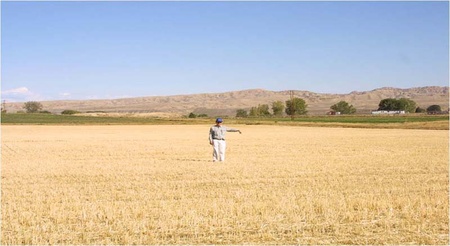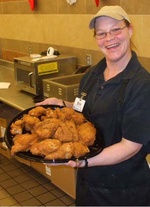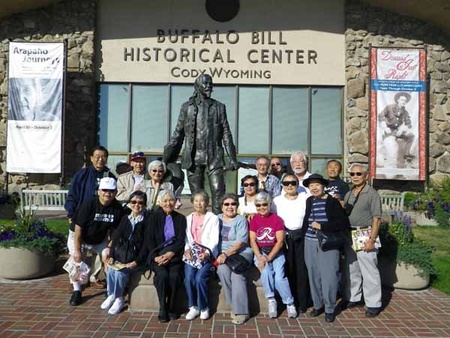Read part 1 >>
I eventually graduated from high school and went to UC Berkeley and then UCLA graduate school, majoring in aeronautical engineering and business. I was hired by Boeing (formerly Douglas Aircraft) and enjoyed a very happy and rewarding 42-year career. Part of my work resulted in the launches of communications satellites and the GPS constellation being placed into orbit. Along the way, I was married, had two daughters and two grandkids.
For over 60 years since leaving Heart Mountain, I wanted nothing to do with it or the Cody and Powell area. After our bitter experience, especially how the people of Wyoming treated us, I had no interest in returning to such a hostile environment.
In the summer of 2007, however, I had an opportunity to return to Heart Mountain. A tour bus stopped at Cody on the way to Yellowstone. I called ahead and asked for someone to escort a few of us former internees to the remaining campground. I learned that a farmer had taken over the camp property and turned it into a large agriculture business.
We drove on the highway between Cody and Powell, and turned in at Road 19. When we arrived at the Heart Mountain site, there was a petite lady waiting for us on the access road to the site. As I walked up to her, she smiled and said, “Are you Sam? Welcome. My name is LaDonna Zall. I am so glad you came. Let me show you around.” We saw the remaining brick and mortar of the high school and hospital. We walked along the remains of barbed wire fences. LaDonna asked, “What was your block and barrack number?” She had prearranged permission with the farmer to walk on the farm property and showed me exactly where my barrack once stood.
Recently, in August 2011, I returned to Heart Mountain for the grand opening of the Interpretive Learning Center, a new museum at the site that houses a collection of camp memorabilia and reconstructed barracks rooms. The opening ceremonies were very impressive with key speakers who included Tom Brokaw, Senator Alan Simpson, Senator Daniel Inouye and Congressman Norm Mineta, also a former internee.
Who I really wanted to meet, however, were the people of Cody and Powell. I wanted to see if there had been a change in their attitudes toward us. And was I surprised.
When we arrived in Cody we first walked down Sheridan Avenue. All along the street, signs in storefronts said, “Welcome Japanese Americans.” People welcomed us, talked with us and made us feel that we belonged.
I arranged for a tour trolley ride so we could see today’s Cody. The trolley owner greeted us and offered to pick us up anywhere at anytime. He showed us the highlights of Cody, and dropped us off anywhere we wanted. We received treatment not given to every visitor.
We went to the Cody Dam where the staff greeted us with a warm welcome, offered our bus driver a choice parking position close to the entrance and gave us rental headsets for touring the dam at no cost. This special treatment was not given to other visitors.
In Powell, we visited the Homesteaders Museum. The receptionist and curator greeted us, showed us the museum’s highlights, and as a special treat, the curator dug into her files and found a photo from 1942 of internees getting off the train, being forced under guard into the army trucks and being taken to barracks. What a memorable gesture, revealing evidence of the start of our internment at Heart Mountain. This was the first time I saw such a photo.
We then went to the cemetery in Powell where the caretaker greeted us with a warm welcome, offered us select parking for our bus, provided cold refreshing water and a clean toilet to freshen up. He showed us the gravesites of three internees who were buried after the graveyard at camp was eliminated. The gravesites were located at the premium front location of the cemetery and were immaculately maintained with well-groomed landscaping.
The evening before we departed Cody for the long trip home, I went to the local Albertson’s grocery store for lunch supplies. The cook in the deli section greeted me with a warm welcome. I described our past meals coming to Cody as boring sandwiches and said we wanted something different. She said she had just the perfect picnic. She suggested their tasty fried chicken accompanied by delicious macaroni salad and cole slaw. She also offered samples for me to taste, which were very good. And she said she would prepare the food fresh the night before our departure, chill it all overnight and put it in a picnic container packed with dry ice to keep it all fresh. I was assured everything would be ready when our bus came by in the morning to pick it up for the trip home. What a departure treat and friendly attitude.
The point of all this is that the people of Cody and Powell and surrounding areas are dramatically different compared to the 1940’s. This change made my lifetime memories of Heart Mountain and Wyoming turn around completely and end on a very positive note.
I look forward to experiencing the positive welcomes and friendly attitudes of the great residents of Wyoming in future visits.
© 2012 Sam Mihara







